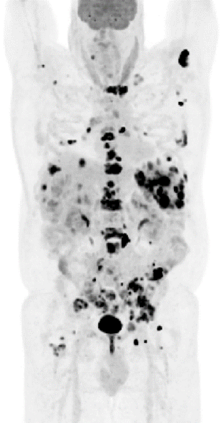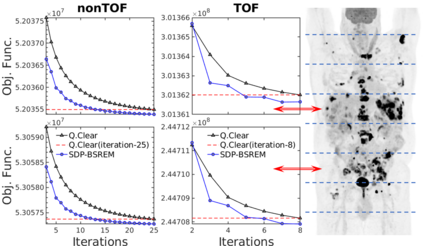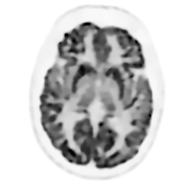We investigated the imaging performance of a fast convergent ordered-subsets algorithm with subiteration-dependent preconditioners (SDPs) for positron emission tomography (PET) image reconstruction. In particular, we considered the use of SDP with the block sequential regularized expectation maximization (BSREM) approach with the relative difference prior (RDP) regularizer due to its prior clinical adaptation by vendors. Because the RDP regularization promotes smoothness in the reconstructed image, the directions of the gradients in smooth areas more accurately point toward the objective function's minimizer than those in variable areas. Motivated by this observation, two SDPs have been designed to increase iteration step-sizes in the smooth areas and reduce iteration step-sizes in the variable areas relative to a conventional expectation maximization preconditioner. The momentum technique used for convergence acceleration can be viewed as a special case of SDP. We have proved the global convergence of SDP-BSREM algorithms by assuming certain characteristics of the preconditioner. By means of numerical experiments using both simulated and clinical PET data, we have shown that our SDP-BSREM substantially improved the convergence rate, as compared to conventional BSREM and a vendor's implementation as Q.Clear. Specifically, in numerical experiments with a synthetic brain phantom, both proposed algorithms outperformed the conventional BSREM by a factor of two, while in experiments with clinical whole-body patient PET data (with and without time-of-flight information), the SDP-BSREM algorithm converged 35\%-50\% percent faster than the commercial Q.Clear algorithm.
翻译:我们调查了一个快速趋同的定序子算法的成像性能,该算法以亚光度依赖最小值的先决条件值(SDPs)来进行正电子发射断层摄影(PET)图像重建,特别是,我们考虑使用SDP(SDP)与块相继定序预期最大化(BSREM)方法,并使用前(RDP)定序法的相对差异,因为供应商先前的临床适应性(RDP)对它进行了调整。因为RDP的正规化有助于重建图像的平稳性,平滑地区的梯度方向更准确地指向目标函数最小值的最小值。根据这一观察,两个SDP(SDP-BEM)设计了光线性平偏向平偏斜地区的递增步数,与SDP-Rloria(SEM-R)的超前两部SM-Slal-Sloria(我们通过模拟和临床的SDP-SEM-Slalal-I)数据比SEM-Slal-Slalal-I-Salalalalalal-I-I-Slation 和SEMM-I-I-I-I-I-I-Ial-I-I-I-I-IL-IL-IL-IL-IL-IL-IL-IL-IL-I-I-I-I-I-I-I-I-I-I-I-I-I-IL-I-I-I-I-I-I-I-I-I-I-I-I-I-I-I-I-I-I-I-I-I-I-I-I-I-I-I-I-I-I-I-I-I-I-I-I-I-I-I-I-I-I-I-I-I-I-I-I-I-I-I-I-I-I-I-I-I-I-I-I-I-I-I-I-I-I-I-I-I-I-I-I-I-I-I-I-I-I-I-I-I-I-I-I-I-I-I-I-






